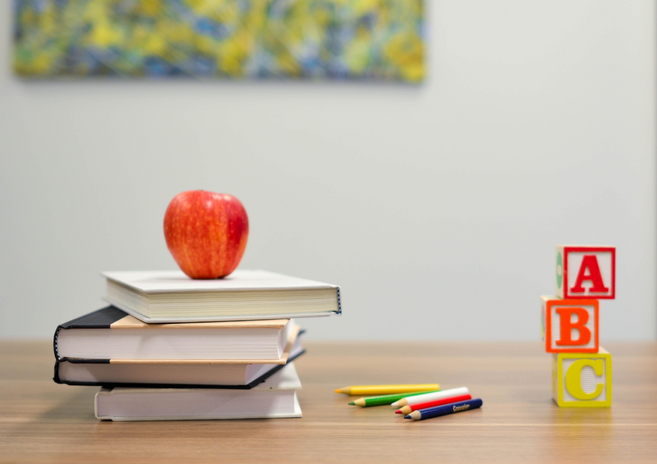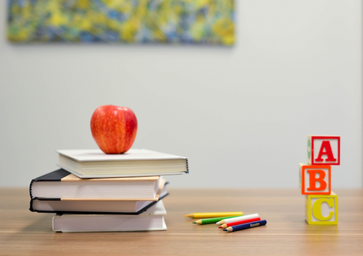Michelle Traylor has been a teacher since 1989. She has worked in Texas, Louisiana and Florida. She is a woman who truly has devotion to educating the future generations of our world. She is warm, patient, fun-loving, kind and selfless. She cannot go to the local grocery store without running into past and current students. With a bright smile on her face, she remembers every child’s name like she taught them that day.
When the pandemic took students out of classrooms, the learning curve was not just for those getting educated but for the educators as well. In this article, I get Mrs. Traylor’s (my mom’s) take on what her job of teaching is like during a global pandemic.

Her Campus (HC): What was your initial reaction when you heard you would have to teach during a lock-down?
Michelle Traylor (MT): I was very apprehensive. You know, because it was the unknown. I felt like it could be great or it could be terrible. I just didn’t know what to expect at the time, so there was a lot of concern. Overall, it has turned out to be great. The students have been responsible for keeping with the safety protocols and everyone has stayed very healthy.
(HC): Has the pandemic affected your ability to teach?
(MT): Well, at the beginning of the school year I was teaching dual platform. Dual platform means I was teaching in-person and online students. This was incredibly stressful. I had never taught virtually before the pandemic. So there was a huge learning curve. On top of that, not only was I trying to learn more about teaching virtually but I was also simultaneously teaching full brick-in-mortar classrooms. So I would say for the first half of the school year it was very difficult. In my attempt to help everyone, I would wonder if I were really helping anyone. I was just spread so thin. The second semester, though, they (the school district) consolidated the distance learners so now I just teach in-person students and it’s much better.
(HC): What is one thing that you wish you could change about distance learning?
(MT): I think the biggest challenge teaching virtually is the accountability aspect. Overall, I feel like I was blessed that the group of students I am working with is fifth grade and they are all very bright. But it is very hard to ensure that they are mastering the learning objectives because the reality is that they are not in school with me. So I have to hope that they aren’t getting help from parents [or] study guides. You know I feel like my students are very trustworthy but there was that concern in the back of my mind of how do I really monitor their progress because I am not with them. I find this very challenging. I think the best way to compensate for this is doing either just online or just in-person per teacher. Doing a dual-platform didn’t allow me to monitor their progress as well. With the number of students I was working with, I wasn’t able to schedule a one-on-one time and mediate their progress as much as I would have wanted to.
(HC): What does a day in your life look like as a teacher during the pandemic?
(MT): 7:45 a.m.: I arrive at school I immediately gather up materials that I am going to need for the day.
8 a.m.: The students arrive at the door, I am required to take everyone’s temperature and record it on a chart. Students are wearing masks and must be fever-free to enter the room.
8:30 a.m.: The students sit at their desk behind plexiglass beginning morning work. They are required to wear a face mask when they are not behind the plexiglass.
8:35 to 10:25 a.m.: I begin teaching my morning block. Students are really cooperative about keeping their masks on. They are allowed to come to the floor if they cannot see beyond their dividers. On the floor, there is a seating chart. There is colored tape on the floor with their names. Students are required to sit with their color group. This is because of tracking purposes. If a student were to test positive the whole class wouldn’t have to quarantine, just that color group.
10:30 a.m.: Recess time! Every class has a scheduled time for recess on a separate playground. No class is allowed to mix. This does make me sad because I know how much the kids like to interact and socialize with other classes.
10:55 a.m.: Students go-to resource. All the resource teachers have seating charts, following the same seating charts as the homeroom teacher. A squirt of hand sanitizer on the way into resource.
11:40 a.m.: Students go to lunch. [There are] seating charts for lunch. Students all face the same direction; no one sits across from anyone. The cafeteria is only at 50 percent capacity. Students stay socially distanced while eating.
12:15 p.m.: The students return to the classroom to prepare for afternoon studies. Teachers put everything on carts that we roll to the next classroom to teach our afternoon class because students are not permitted to leave the classroom. I teach language arts and social studies to my afternoon class.
2:35 p.m.: The students begin to pack up and teachers go back to homeroom to dismiss students.
(HC): What do you guess the future looks like for teaching moving forward?
(MT): It appears that there will be more virtual learning in the future. Some students and families that choose to do virtual learning this school year like it and will probably choose to continue it. I am optimistic that as more people get vaccinated, we will be able to return to a more traditional setting where children are allowed more freedom to socialize and share materials.
Want to see more HCFSU? Be sure to like us on Facebook and follow us on Instagram, Twitter, TikTok, Youtube and Pinterest!



